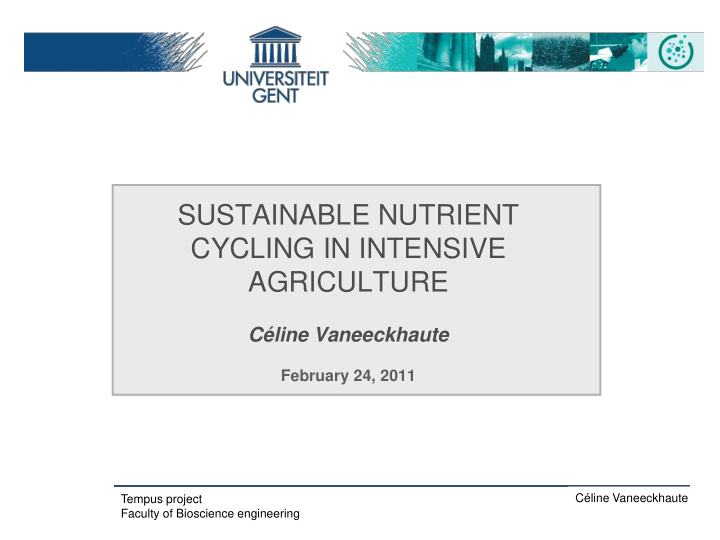



SUSTAINABLE NUTRIENT CYCLING IN INTENSIVE AGRICULTURE Céline Vaneeckhaute February 24, 2011 Céline Vaneeckhaute Lab. of Analytical & Applied Ecochemistry Tempus project Faculty of Bioscience engineering
Presentation overview I. General introduction II. Research objectives III. Preliminary results IV. Perspectives Céline Vaneeckhaute Tempus project TNAV: Academia Meets Industry Faculty of Bioscience engineering
I. General introduction Céline Vaneeckhaute Tempus project Faculty of Bioscience engineering
The Flanders situation Intensive industrial farming has Manure excess on soil balance Exceedance over EU Nitrate directive resulted in localised nutrient % in 2003-2004 (N,P) excesses at a regional level % in 2004-2005 % in 2005-2006 Similar situations in US (NC), France (Bretagne), The Netherlands, Germany (Nord Westfalen), Italy, etc.
Manure processing Animal Solid manure fraction Soil enhancer Physical separation Composting Liquid fraction Fertilizer Nutrient reduction by Spreading over land biological treatment Céline Vaneeckhaute Tempus project BIWA workshop IVPV Overlegplatform water Faculty of Bioscience engineering Faculteit Bio-ingenieurswetenschappen
Manure processing Soil Animal Solid enhancer manure fraction Composting Physical separation Fertilizer Liquid Spreading over land fraction Dischargeable water Constructed wetlands Nutrient reduction by biological treatment Dischargeable water Anaerobic digestion Céline Vaneeckhaute Tempus project Overlegplatform water Tempus Overlegplatform water Faculty of Bioscience engineering Faculty of Bioscience engineering Faculteit Bio-ingenieurswetenschappen
Problem statement Nutrient excess vs. nutrient depletion • Artificial fertilizer use & import: * - Flanders: 26 million kg N & 4,5 million kg P 2 O 5 * - EU: 10,5 million tonnes N & 2,7 million tonnes P 2 O 5 • Fossil fuel consumption for artificial nutrient production is high : * - 37,4 GJ / ton NH 4 - 2 liters oil / ton N * • Prices for artificial fertilizers are increasing • Nutrient resources are depleting: especially phosphorous! => Important to maximally recuperate & recycle valuable nutrients from manure processing Céline Vaneeckhaute Lab. of Analytical & Applied Tempus project Ecochemistry Faculty of Bioscience engineering *European Fertilizer Manufacturers Association, 2009
II. Research objectives Céline Vaneeckhaute Tempus project Faculty of Bioscience engineering
Research objectives Crop production Energy External energy crops & nutrients Green Feed Manure fertilizers + energy Nutrient processing Manure Livestock Biogas production production Feed Renewable energy Organic-biological waste Céline Vaneeckhaute Lab. of Analytical & Applied Ecochemistry Tempus project Faculty of Bioscience engineering
Research objectives GREEN FERTILIZERS ? Céline Vaneeckhaute Lab. of Analytical & Applied Ecochemistry Tempus project Faculty of Bioscience engineering
Research objectives • During manure and digestate treatment various nutrient rich derivatives are being produced which could potentially be re-used as green substitutes for mineral fertilizers produced by fossil fuels (= green fertilizers) • Ex.: Concentrates produced by membrane filtration, waste water from air scrubbers, etc. • This research aims to: - Investigate the fertilizer value of these products by means of physico- chemical characterizations (EC, pH, macro- & micronutrients, speciation) - Situate the bottlenecks for agricultural re-use - Assess pot- & field experiments to investigate the impact on soil chemistry, soil fertility and soil quality by agricultural application of these products Céline Vaneeckhaute Lab. of Analytical & Applied Ecochemistry Tempus project Faculty of Bioscience engineering
III. Preliminary results Céline Vaneeckhaute Tempus project Faculty of Bioscience engineering
Preliminary results Membrane filtration concentrates • Principle: Treatment of liquid fractions into dischargeable water by means of intensive membrane filtration (Reversed Osmosis) • Fertilizer value: - N-content: 5,9-6,4 kg N/ton FW (cfr. animal manure) - N-efficiency: 82% (> animal manure) - K-content: 5,1-13 kg K 2 O/ton FW (> animal manure) => Potential N-K fertilizer • Bottlenecks for re-use: - Salt content: Risk of soil degradation - Potassium content: Risk of head illness for cattle - Ratio Na, K / Ca, Mg (Sodium Adsorption Ratio): Risk of soil compaction Céline Vaneeckhaute Lab. of Analytical & Applied Ecochemistry Tempus project Faculty of Bioscience engineering
Preliminary results Waste water from NH 3 -scrubbers • Principle: Removal of NH 3 from air by addition of H 2 SO 4 and formation of (NH 4 ) 2 SO 4 • Fertilizer value: - N-content: 13-17 kg N/ton FW (> animal manure) - N-efficiency: 100% (> animal manure) => Potential N-S fertilizer • Bottlenecks for re-use: - Salt content: Risk of soil degradation - H 2 S-formation: Toxique at low concentrations! - Corrosive and acidifying product Céline Vaneeckhaute Lab. of Analytical & Applied Ecochemistry Tempus project Faculty of Bioscience engineering
IV. Perspectives Céline Vaneeckhaute Tempus project Faculty of Bioscience engineering
Perspectives • There are potential green fertilizers produced by manure and digestate treatment • Pot & field experiments are necessary to investigate the impact on soil chemistry, soil fertility and soil quality by application of these new potential green fertilizers • Nutrient balances (soil, plant, ground water) should be assessed and compared with those for conventional fertilizers • Potential re-use in the chemical industry ? Céline Vaneeckhaute Lab. of Analytical & Applied Ecochemistry Tempus project Faculty of Bioscience engineering
Recommend
More recommend